The refined plans for a 61-story tower to rise up to 800 feet in height at 542-550 Howard Street (a.k.a. Transbay Parcel F) were approved by San Francisco’s Planning Commission early last year, plans which could yield 165 condos, a 189-room hotel, 275,000 square feet of office space and 9,000 square feet of retail, with a basement garage for 183 cars and a pedestrian bridge connecting the tower to the park atop the Transbay/Salesforce Transit Center.
As we noted at the time, all 165 of the tower’s condos were designed to be sold at market rates, with the required inclusionary housing (BMR) component of the project to be fulfilled off-site, within a 713-unit building proposed to rise on the northern third of the temporary Transbay Terminal site, fronting Howard Street between Beale and Main (a.k.a. Transbay Block 4).
But in order to receive an occupancy permit for the 165 market-rate condos atop the Parcel F tower, the 33 below-market rate units for the project would first have to be built on Block 4.
And citing “the practical challenges” and “financing risk” associated with conditioning the occupancy of the 165 tower units with the “timely completion of a separate, offsite project,” a structure which the development team, which is led by Hines, had actually proposed, F4 Transbay Partners is now seeking approval to pay an enhanced in lieu fee of around $45 million to the City’s Office of Community Investment and Infrastructure (OCII) to fund the development of affordable housing in the District rather than include any affordable housing for the tower either on or off-site, a proposal which is slated to be conditionally approved by the Commissioners of the OCII this afternoon.
At the same time, building permits for the Parcel F tower have been requested and are close to being approved. We’ll keep you posted and plugged-in.
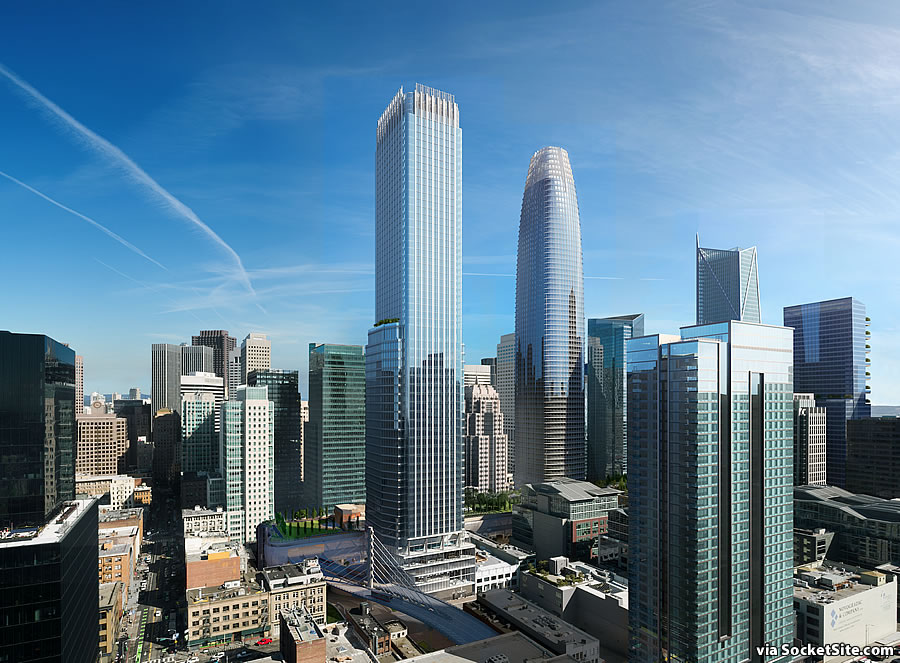
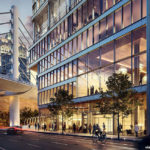
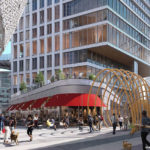
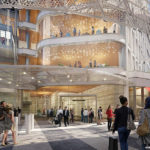
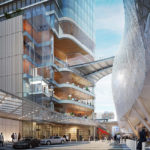
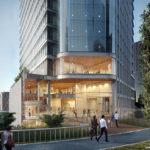
$45 million for 33 BMR units, only in SF…
The fee is intentionally higher than the cost of building 33 BMR units because it’s supposed to push the developer to do it themselves. I have no complaint against this situation. We’ll still get an awesome new building, and the city will be able to do a lot more with that money than the developer would have done building 33 units.
Actually, San Francisco’s Transbay Redevelopment Plan doesn’t allow for the inclusionary housing requirement to be satisfied by way of an in lieu fee for a development within the Transbay District, in part due to the affordable housing requirements for the district that were imposed by the State, requiring at least 35 percent of the units within the Redevelopment Area to be affordable to low and moderate income households, in exchange for the land.
And that’s why the proffered fee is so “only in SF” high (as it was for the affordable-housing-free development atop the tower at 181 Fremont Street).
Awesome bldg? For who?
Just another tony condo/hotel at a time where we’ve proven we can live well without as such.
It’s correct that San Francisco’s Transbay Redevelopment Plan doesn’t allow for the inclusionary housing requirement to be satisfied by way of an in lieu fee (in fact, it only allows on-site delivery), this requirement is totally impractical for new high-rise for-sale housing where HOA fees, combined with even affordable-level mortgage payments, taxes and insurance more than exceed reasonable housing costs (33%) for low and middle income families, thus the need to offsite BMR units or pay a fee. This is also the reason the City allows three (sometimes four) options for meeting BMR requirements – because certain options don’t always work for every project.
Didn’t they decrease the height by 50ft? It’s 750 ft now?
No. It’s 750 feet to the top of the highest occupied floor, 800 feet to the top of its rooftop screen/crown.
Gotcha – just saw that on the SF Planning Agenda and was curious. Thank you for clarifying!
Hot take: This deal will get completed and leased before Oceanwide resumes construction.
Looks like there’s some bubbling of an Oceanwide takeover.
No way, They won’t be able to get financing and this project will go into the unending 3 year permit extension process. Exactly as did the Howard Street skinny tower. In the works since 2013 and in the midst of yet another permit extension.
Keep in mind that F4 Transbay Partners is a joint venture between Hines, Urban Pacific Development and an affiliate of Goldman Sachs.
“San Francisco’s next major skyscraper — a 61-story mixed-use tower planned for 550 Howard St. in the Transbay District — will break ground in the first quarter of next year and will include a deluxe 180-room Rosewood Hotel, the developer announced on Thursday.”
Or as we first reported earlier this year: Change in Plans to Expedite Development of New Tower
Having written this post with only a single sentence making up all but one of its “paragraphs,” and having its lede buried near its bottom, the writer has made it very difficult to understand whether any developments have occurred regarding this … development. 😉
Developments are occuring as fast as the development entitlements are being sold….
The idea that a permanently 5 years-out city that can’t budget can be trusted to use the money to construct a quality BMR and not pocket the cash seems like an absurd fantasy.
Basement garage for 183 cars in a building that has a direct walkway to the Grand Central Station of the west. Ridiculous. The Transbay plan should have banned off-street parking entirely.
It turns out allowing parking was a good idea as the TTC will not be the Grand Central Station of the West. A CalTrans extension isn’t likely to come there now let alone HSR.
What Scott fails to understand is that you can call the TTC anything that you want, but the idea of a train rolling into the TTC any time in the next two decades would be a miracle. That’s what’s ridiculous about this. False promises for rail. Billions spent on a bus station. Heck, not even a direct walkway to the existing rail under Market St. You want rail done right? Look across both oceans.
The failed promise of rail to downtown was, in part, to have an excuse to upzone the immediate area around the TTC. The thing that should have been mandated as part of the upzoning would have been to tie use of the new rights to real progress in getting the promised rail to downtown..
Now those additional building heights are not worth so much. Oceanwide has been abandoned, Parcel F is not likely to actually get built and the City is stuck with an eyesore – the Salesforce tower. It is shown in almost every photo that accompanies a story about the exodus of people and business from SF. The photos reinforce what an architectural miss it is.
“[,,,] an excuse to upzone the immediate area around the TTC.”
Bingo. Follow the money. Hello, FBI?
Yes, it’s definitely a conspiracy to upzone an area immediately adjacent to the central business district of a major city…
Get real.
Uh, the Sales Force Tower is a prominent tower in the city’s core business district. So yes, when a news article includes a current picture of the downtown skyline, one will likely see the tower in the shot. You are truly reaching with your comment about how news articles “reinforce what an architectural miss it is”. We get it, you don’t like it. Fine. Move on
Also, don’t you get bored spending so much time on this site being what could be most charitably described as a half-baked urban design critic who fancies himself a modern day Cassandra always moaning about the impending fall of the city? Wouldn’t it be more interesting, or at least more productive, spending your time and energy focused on a city you actually lived in?
Agreed that rail at TTC seems like a fantasy now. Given the history of the SFMTA, BART, MTC, BATA, etc none of our local transportation agencies can deliver a big project in less than 20 years and 500% over budget. So yes, and sad to say, this project should include parking.
Why do people keep calling the Transbay Terminal the “Grand Central Station” of the west? There is nothing grand about it with its potential for all of three platforms. Grand Central Station has 44 platforms and 67 tracks with more once the LIRR extension is done. If anything, LA’s Union Station is the “Grand Central Station” of the west. All San Francisco has is a really expensive, fancy terminus.
The actual title is Grand Central Terminal…the failure of people to cite it properly, I suppose, underscores just how unapt is the comparison.
Same reason people have spent decades calling even mid-rise development in SF and the broader Bay Area “Manhattanization”. Bad (and usually wrong) comparisons to New York are found in cities across the country.
At a time when wealthy people and corporations are loudly (and sensibly) fleeing the bay area, this consortium wants to bet on SF in a big way, and with no public money. The planning commission should give them a big, wet kiss and rubber stamp the plans before these investors follow the others to Austin or Miami.
Austin and Miami are great places but they’re nothing like SF. IMO many of those folks will be back, especially those who want urbanity. Right now tho? Yeah, I’m anecdotally hearing things like 90 offers on 3br 2 1/2 ba houses in Zilker
Miami won’t exist in 50 years. We’ll see how excited everyone is after their first hurricane.
have you ever heard of the netherlands? been below sea levels for centuries, but technology solved it. same will happen in miami. hurricans a differnt story
The Dutch had a massive storm in the 50s and they built infrastructure afterward to prevent such events from recurring. The Netherlands is a singular body. Where is the American will to create massive — preemptive — federally funded flood protection infrastructure in a federalist system? Texas, Louisiana, Florida … these states don’t have the political will or even makeup to be preventative. So it’ll be necessarily be reactive. Say what you will about California but it taxes itself and will take on its own problems.
Yes. I have heard of the Netherlands. Have you heard of limestone? That’s the rock upon which Miami is built on. It’s porous. That means that dykes don’t work, because the water bubbles through the rock itself.
Netherlands? No limestone.
In this instance, I think Ohlone Californio is correct. The Mayor of Miami’s recent tactics to attract S.F.’s venture capital crowd to that Florida city are almost self-defeating.
Affluent and tax averse people who flit from one overpriced metropolitan area to the next are the exact same people who will leave at the drop of a hat once taxes are assessed to address a long-term problem like drinking water contamination due to the rising Atlantic which will cover much of Miami by the end of this century.
The Dutch wanted to preserve their country and way of life for future generations. The crowd that is leaving S.F. for Miami now are rootless cosmopolitans only concerned about their personal wealth and are only in S.F. (for now) to make whatever money they can and then run away with as much of it as possible before the music stops.
“Intensive care units in some Southern regions are filled entirely with COVID patients and have no available beds. In at least six states — Alabama, Arkansas, Florida, Georgia, Mississippi and Texas — more than 90% of all ICU beds are occupied, according to the Center for Infectious Disease Research and Policy at the University of Minnesota….
‘The big picture of San Francisco is … people were willing to stay home and willing to wear masks that mitigated the full impact of the pandemic,’ she said. ‘What it means now is at San Francisco General today we have 25 people with COVID in the hospital. But if you were in Florida or Mississippi or Texas, hospitals are completely overwhelmed.'”
Austin and Miami have their charms, but like many business owners, I prefer to live in a city where voters are willing to pay taxes to support a strong Public Health Department, in a city where the vast majority of people are willing to follow public health advice and get vaccinated, and in a state where the Governor and Legislature follow sound public health guidance.